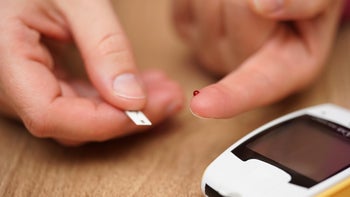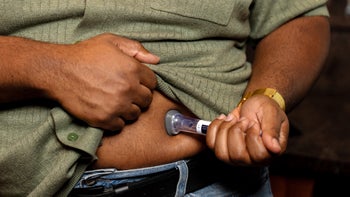
Can You Cure or Reverse Diabetes?
Key takeaways:
Diabetes is not curable. There are no treatments that can make it go away completely, but some people with Type 2 diabetes may be able to go into remission.
Many people with diabetes will need to take medication for life. But new technologies are helping to simplify how people manage diabetes.
While there’s no cure yet, there’s a lot of diabetes research underway. So look out for new medications and devices that can ease the day-to-day burdens of managing diabetes.

If you have diabetes or know someone who does, you know that treating it can really change day-to-day life. While there are treatments to slow diabetes, there isn’t a cure yet. So managing diabetes often means taking daily medication over the course of a lifetime.
The good news? Thanks to a huge amount of current diabetes research, there are many new treatments on the horizon. And for some people with Type 2 diabetes, it may be possible to go into remission. This doesn’t mean that your diabetes is cured, but it means your blood sugar has returned to a normal range. And that can help prevent a range of diabetes-related health conditions.
So if you’re looking to curb the effects of diabetes and streamline how you manage your health, here’s a guide to current diabetes treatments and those that are closest to a cure.
Save on popular GLP-1 Agonists
Take control of your health. With GoodRx, you may be eligible to save even more on popular treatments.

Diabetes basics
Diabetes is a health condition where blood sugar (glucose) levels are too high. The body normally uses glucose as a good source of energy. But with diabetes, the body has a hard time balancing the energy it gets with the energy it needs.
At the root of the problem is insulin, a hormone made in the pancreas.
Normally, insulin helps the body move glucose from the bloodstream into the cells, where it’s used for energy. But in people with diabetes, the body doesn’t make enough insulin, or the body doesn’t use it very well. This means that too much glucose stays in the bloodstream — and not enough gets into the cells, tissues, and organs. Over time, high blood sugar can cause many different health issues.
Are there different types of diabetes?
Yes, there are several different types of diabetes. Here are the most common types of diabetes and what causes them:
Type 1 diabetes (T1D): This is an autoimmune disease. The body becomes confused and attacks its insulin-producing cells. People with T1D need to take insulin for the rest of their lives. About 5% to 10% of people with diabetes have T1D.
Type 2 diabetes (T2D): This is when the body doesn’t react properly to insulin. Many people with this type of diabetes also don’t make enough insulin. About 90% to 95% of people with diabetes have T2D.
Prediabetes: This is when your blood sugar is too high to be healthy, but not high enough for you to be diagnosed with diabetes. It’s an early and potentially reversible type of T2D.
Gestational diabetes: This is when T2D happens during pregnancy.
Other types of diabetes: There are other types of diabetes related to cystic fibrosis or certain medications that raise blood sugar.
Both T1D and T2D are chronic (ongoing) health conditions. This means that once you’re diagnosed with diabetes, you will have it for the rest of your life. Though there’s no cure, some people with diabetes are able to bring down their blood sugar to a range that isn’t considered diabetes. This is diabetes remission.
Let’s go through the two main types of diabetes (T1D and T2D) and talk about where researchers are in the search for a cure.
Is there a cure for Type 1 diabetes?
There are no treatments to cure or reverse Type 1 diabetes. Here’s why.
Type 1 diabetes happens when the body doesn’t make any insulin or makes very little of it. It’s an autoimmune disorder where the body’s immune system destroys the cells in the pancreas that make insulin.
This means that a cure for T1D would need to do two things:
Stop the immune system from destroying more pancreas cells.
Replace the pancreas cells that have already been destroyed.
While research is promising, there are no curative therapies for T1D — yet. For now, new medications and technologies are making diabetes easier to manage than ever before. Medications and diabetes devices (glucometers, continuous glucose monitors, and insulin pumps) can help to improve glucose values while lowering the burden of daily management.
What does an ‘artificial pancreas’ do?
An automated insulin delivery (AID) system is a smart device that helps keep glucose levels within target range. It does this by adapting insulin delivery to your current glucose levels. Most people who use an AID device have T1D, but some people with T2D use them, too.
AID systems are made of three parts:
An insulin delivery device (tube or patch pump)
A continuous glucose monitor (CGM)
Software that tells the pump when and how much insulin to deliver
AID systems act like an “artificial pancreas” by doing the job of a normal, healthy pancreas. To prevent low blood sugar, they know when to stop giving insulin. And they know to give insulin when glucose levels rise. This means less guesswork, improved time in-range, and a lightened load of disease management.
In a large review from 2018, researchers found that an AID system was often better at keeping sugar levels in the normal range than other insulin delivery methods. And in other studies, AID systems were better at keeping blood sugars normal during intensive exercise than other insulin systems.
Are pancreas transplants an option for people with Type 1 diabetes?
Yes, but they’re not very common. Though a transplant is probably the closest thing to a true cure, these types of surgeries aren’t done very often. This is because it’s a risky surgery with a difficult recovery. And people with this transplant need to take anti-rejection medications for life. Plus, after the transplant, many people still need some kind of insulin — and they may get diabetes again.
A transplant is usually only considered for people with Type 1 diabetes who also need a kidney transplant.
Will researchers ever find a cure for Type 1 diabetes?
Researchers are working hard to find new therapies for diabetes. Hopefully they’ll find a cure at some point. Here are some areas where a lot of research is being done.
Pancreas cell transplants and regeneration
Instead of transplanting a whole pancreas, this procedure transplants the parts of the pancreas that are damaged in Type 1 diabetes (islet cells). And it helps these cells to regrow. This is called islet cell transplant and regeneration. For people with T1D, it could someday be a treatment, or even a cure.
Immunotherapy
Immunotherapy is another area of active research on Type 1 diabetes. This uses medications to treat the immune system so it turns on or off parts of the immune system in the body.
Immunotherapy is already being used to treat other things, like allergies and cancer. By keeping the immune system from attacking the pancreas, immunotherapy may also be helpful for people with T1D at some point.
Doctors and scientists are currently testing immunotherapy for diabetes. It may end up working best in people who’ve recently been diagnosed with diabetes. The idea is that early use of immunotherapy might stop more damage to the pancreas. This would let some of the cells stay healthy and continue to work well. It’s also possible that turning off this autoimmune damage may help the pancreas start to function normally again.
Gene therapy
Gene therapy is a type of treatment that changes certain genes in the body. And since diabetes is connected to genetics, a true cure may be found in a genetic treatment. Gene therapy may be able to either stop the disease from happening or correct the problems that the disease causes. Right now, there are only a few rare diseases that have been successfully treated with gene therapies.
Though gene therapy isn’t a cure yet for diabetes in humans, scientists have been able to use it to cure diabetes in mice. This is an area of ongoing research. The next steps are to test this approach in human trials. In the future, gene therapy may hold a cure for Type 1 and maybe even Type 2 diabetes.
Can you cure Type 2 diabetes?
No. But for some people, it’s possible to go into remission (sometimes called “reversing” diabetes). Being in remission means that your blood sugars are in the normal range, even though you still technically have diabetes.
Lifestyle changes, especially losing weight, may help some people with Type 2 diabetes go into remission. But keep in mind: Diabetes is caused by a combination of genetics, lifestyle, and environmental risk factors. You can change some of these things, but not all of them.
Risk factors that you can’t control include:
Pre-birth experiences: Diabetes risk can start as far back as development in pregnancy (metabolic programming). When a baby is exposed to malnutrition or high blood glucose levels during pregnancy, this can increase the risk of Type 2 diabetes later in life.
Family history of trauma: Sometimes risk goes even further back. Epigenetics, or multigenerational stresses and experiences, can change the way genes are switched on or off, increasing risk for chronic disease in your life and your family line.
Genetics: If diabetes runs in your family, you might also be more likely to have it.
The following are all considered “reversible” risk factors for Type 2 diabetes:
Excess body fat, especially around the abdominal area
Eating a diet high in refined sugar and processed foods, and low in whole, unprocessed foods
High levels of stress
A lack of regular, good quality sleep
The best evidence points to weight loss as the number one factor that can help put diabetes into remission — either through diet changes or bariatric surgery (more on these below). Your chances for remission may also depend on how well your pancreas works and how long you’ve had diabetes.
Can you reverse prediabetes?
Yes. It’s possible to reverse early Type 2 diabetes, or prediabetes. Prediabetes is when blood sugar is high, but not high enough for a diabetes diagnosis.
In some cases, prediabetes can lead to Type 2 diabetes. But up to 1 in 3 people with prediabetes are able to reverse it by changing their diet, exercising, and (if necessary) losing weight.
Looking for more information specifically about this topic? Check out our GoodRx guide to reversing prediabetes.
Can nutrition and exercise help with Type 2 diabetes?
Yes. For people with Type 2 diabetes, exercise, good nutrition, and weight loss can slow T2D or even reverse it. Not only that, it can improve (and even reverse) some health complications of diabetes, like kidney and eye problems.
These changes work best when combined. They also have the greatest effect in the first year. You’re more likely to have longer-lasting benefits from intensive lifestyle changes if:
You can maintain weight loss over time.
Your blood glucose level is at the lower end of the diabetes range at the time of diagnosis (rather than very high).
The Look AHEAD trial has the most evidence looking at the effect of an intensive lifestyle intervention program on health outcomes in Type 2 diabetes. The people in this trial all had Type 2 diabetes and a BMI (body mass index) over 25. They were randomly assigned to standard diabetes education or the intensive intervention program. The program involved calorie restriction through set meal plans, moderate-intensity physical activity (175 minutes per week), and weekly sessions with dietitians, behavioral psychologists, and exercise specialists.
The Look AHEAD trial found that intensive lifestyle intervention resulted in:
Greater weight loss, especially at 1 year
Smaller waist circumference
Better blood glucose levels, especially in the first year
Slight improvement in LDL (“bad”) cholesterol levels
Lower use of medications for diabetes, blood pressure, and cholesterol
Less kidney damage
For many people, it’s no easy task to lose 7% to 10% of their starting weight and get 175 minutes of exercise a week. In the research studies quoted, the participants were enrolled in highly structured lifestyle programs. This made sure that people had the continued support they needed to reach their weight and exercise goals. But not everyone can afford a lifestyle coach or a dietitian.
And here’s the catch: To keep your inbuilt, genetic risk for diabetes in check, you have to maintain lifestyle changes over the long term.
A small study on what got people started and kept them going in their lifestyle changes showed that the three most important factors were:
Getting education about diabetes and nutrition
Having the support of others
Feeling a difference in their health
The participants with the greatest success were those who made new habits that stuck.
But remember, there’s no one-size-fits-all lifestyle program. For some people, lifestyle changes will not be enough.
Can weight-loss surgery help people with Type 2 diabetes?
Yes. Weight-loss surgery (bariatric surgery) can significantly improve Type 2 diabetes in people with high body fat. And it may even return blood glucose levels to normal levels in some people.
There’s international medical agreement that weight-loss surgery should be an option for people who have have:
A BMI of 30 or higher
Type 2 diabetes
Not been able to lose weight or improve their diabetes with lifestyle changes and medication
But this isn’t a perfect or easy solution. Bariatric surgery is major surgery and requires real personal and financial commitment. Plus, a significant number of people get diabetes again down the line. Nevertheless, it’s a good option for some people.
The bottom line
There’s a lot of diabetes research happening right now. But despite many developments in treatment over recent years, there are no treatments that can reverse or cure diabetes yet. For people with Type 1 diabetes — and most people with Type 2 diabetes — adopting a diabetes-friendly lifestyle and taking regular medication will be lifelong practices.
Some people with prediabetes or early Type 2 diabetes can prevent diabetes from getting worse and may delay or lower the need for medication with intensive lifestyle changes. This includes a calorie-restricted diet, weight loss, and lots of moderate-intensity exercise.
Why trust our experts?



References
American Diabetes Association. (2021). International experts outline diabetes remission diagnosis criteria.
American Heart Association. (2021). Diabetes risk factors.
Bekiari, E., et al. (2018). Artificial pancreas treatment for outpatients with type 1 diabetes: systematic review and meta-analysis. British Medical Journal.
Burke, G. W., III., et al. (2015). Lessons from pancreas transplantation in type 1 diabetes: Recurrence of islet autoimmunity. Current Diabetes Reports.
Cefalu, W. T. (2020). Achieving type 2 diabetes remission through weight loss. National Institute of Diabetes and Digestive and Kidney Diseases.
Centers for Disease Control and Prevention. (2022). Type 2 diabetes.
Centers for Disease Control and Prevention. (2022). What is epigenetics?
Coppieters, K., et al. (2018). The development of immunotherapy strategies for the treatment of type 1 diabetes. Frontiers in Medicine.
Diabetes Action Research and Education Foundation. (2023). Current research.
Diabetes Research Institute Foundation. (n.d.). Research progress.
Diabetes UK. (n.d.). Diabetes remission.
Doiron, B., et al. (2016). Beta cell formation in vivo through cellular networking, integration and processing (CNIP) in wild type adult mice. Current Pharmaceutical Biotechnology.
Fall, C. H. D., et al. (2018). Metabolic programming in early life in humans. Philosophical Transactions B.
Garvan Institute of Medical Research. (2022). World-first gene therapy clinical trial for type 1 diabetes to proceed.
JDRF. (2019). Immunotherapies.
JDRF. (n.d.). Cell therapies.
Kashyap, S. R., et al. (2010). Bariatric surgery for type 2 diabetes: Weighing the impact for obese patients. Cleveland Clinic Journal of Medicine.
Lean, M. E. J., et al. (2018). Primary care-led weight management for remission of type 2 diabetes (DiRECT). The Lancet.
Look AHEAD Research Group. (2007). Reduction in weight and cardiovascular disease risk factors in individuals with type 2 diabetes: One-year results of the look AHEAD trial. Diabetes Care.
Mobasseri, M., et al. (2020). Prevalence and incidence of type 1 diabetes in the world: a systematic review and meta-analysis. Health promotion Perspectives.
Mohamed, Q., et al. (2007). Management of diabetic retinopathy: A systematic review. The Journal of the American Medical Association.
Morales, E., et al. (2003). Beneficial effects of weight loss in overweight patients with chronic proteinuric nephropathies. American Journal of Kidney Disease.
National Institute of Diabetes and Digestive and Kidney Diseases. (2021). Artificial pancreas.
Rathod, S. (2022). Novel insights into the immunotherapy-based treatment strategy for autoimmune type 1 diabetes. Diabetology.
Rise, M. B., et al. (2013). Making and maintaining lifestyle changes after participating in group based type 2 diabetes self-management educations: A qualitative study. PloS One.
Rubino, F., et al. (2016). Metabolic surgery in the treatment algorithm for type 2 diabetes: A joint statement by International Diabetes Organizations. Diabetes Care.
Sutherland, D. E. (1996). The case for pancreas transplantation. Diabetes & Metabolism.
Tuso P. (2014). Prediabetes and lifestyle modification: Time to prevent a preventable disease. The Permanente Journal.
United Kingdom Prospective Diabetes Study Group. (1995). United Kingdom prospective diabetes study (UKPDS) 13: Relative efficacy of randomly allocated diet, sulphonylurea, insulin, or metformin in patients with newly diagnosed non-insulin dependent diabetes followed for three years. BMJ: British Medical Journal.
Vertex Pharmaceuticals Incorporated. (2023). Vertex announces FDA clearance of investigational new drug application for VX-264, a novel encapsulated cell therapy for the treatment of type 1 diabetes.
Wylie-Rosett, J., et al. (2002). An integral role of the dietitian: Implications of the Diabetes Prevention Program. Journal of the American Dietetic Association.

























